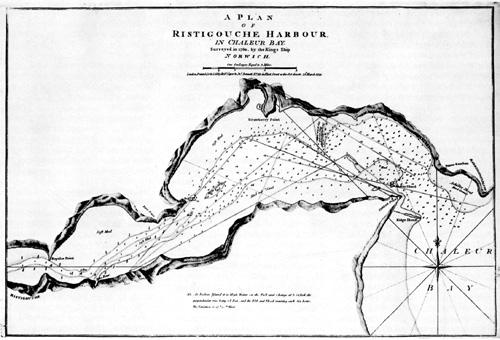|
|
 |
Canadian Historic Sites: Occasional Papers in Archaeology and History No. 16
The Battle of the Restigouche
by Judith Beattle and Bernard Pothier
Chaleur Bay
Why, when faced by the fact that the British had won the race to the
St. Lawrence, did the French turn to Chaleur Bay for refuge? The secret
instructions under which Giraudais was operating clearly stated that in
such an event the fleet was to proceed to Louisiana and St. Domingue to
discharge the troops and goods.1 For some reason, the fleet
disobeyed these orders.
Chaleur Bay would appeal to the men on the three French ships for
several reasons. The troops were predominantly former members of the
company of Ile Royale. Some had been on expeditions in the
Miramichi-Chaleur Bay area about the time of the capture of the
Fortress of Louisbourg2 and knew of the posts in the area. They
also knew that the British had little accurate information about this
part of Acadia. But their most pressing need was food. Even though the
French carried foodstuffs in their cargo, their own rations were
depleted; much of the beef and horse flesh supplied for their rations
was rotten,3 the biscuit had been used and fresh bread could
not be baked aboard ship. Fresh water was also needed. Of all the areas
where their needs could be met, it was felt that the Restigouche River
would best fulfill all requirements.
By 1760 Restigouche River was a centre for Acadian refugees. A
mission to the Micmacs, active since the early 1700s, formed the nucleus
of the settlement at Old Mission Point. After the expulsion order in
1755, escaping Acadians made their way to the Saint John, Miramichi and
Chaleur Bay areas. Macbeath dates the prominence of the Chaleur Bay area
from 1758 "when Louisbourg fell and the Miramichi and St. John were
raided."4 Families began to gather from Ile Saint-Jean and
Gaspé when the French set up a post near Pointe à Bourdeau on the
Restigouche,5 but the difficulty of sending stores to this
area caused great suffering to the growing group of refugees. Bourdon,
the head of the post, wrote in April 1760, "La disette est si grande
qu'après avoir mangé les animaux domestiques nous avons été obligés de
manger des peaux do boeuf et de castor pour subsister6 Not
only did the French ships sorely need a safe, secluded harbour in which
to prepare themselves for a long voyage, but the residents of the
Restigouche sorely needed the stores the ships carried.
About 18 May the fleet and its train of prizes proceeded into
Chaleur Bay. Near its mouth they discharged St. Simon, the swiftest and
most trustworthy of the troops, to carry news from France and from the
ships overland to Montreal. The next day the troops were landed on the
north shore (at Pointe à la Batterie) and a camp established. While one
party of sailors set to work building a battery, another unloaded one of
the prize ships, the Augustus, to serve as a scout. Ovens were
built to bake bread and fresh water was obtained.
Captain D'Angeac, now commander of all the troops, discovered the
desperate straits of the Acadians at Bourdon's post.
J'ai trouvé dans ce Sejour de Misere plus de mille cinq cents
ame Extenué de nanisions et mourant de faim ayant été obligé de
mange des paux de Castore pendant tout l'hiver a qui je fait donner une
demie Livres de farine par jour et un Cartron de Boeuf en atendant des
ordres de Monsieur le Marquis de Vaudreuil ce petit secours les a tiré
de portes de la mort ce que je continue jusqu'à ce
jour.7
Each day, as word spread of the fleet's cargo, Acadians gathered to
share the food. But little was done either to protect the fleet or to
relieve it of its cargo. The only precaution taken was to send out, on
12 June, a reconnaissance craft under the Sieur Lavary le Roy, a first
lieutenant from the Machault. While waiting for the messenger to
return from Vaudreuil in Montreal, the French considered themselves to
be well-protected in their harbour.

2 "A Plan of Ristigouche Harbour, In Chaleury Bay, Surveyed
in 1760, by the Kings Ship Norwich. One Sea League
Equal to 3 Miles."
(Public Archives of Canada.)
|
|

